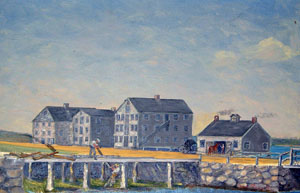Historical Paintings of Woods Hole and Falmouth by F. L. Gifford

Water Street, Woods Hole, 1845
In this westward view of Water, or Main Street is Woods Hole seen from the landward end of Dyer's dock. Only one of the four buildings shown remains standing: the Candle House (11) farthest down the street. Next nearer is the Bake Shop (13) where hardtack was baked and packed for whaling ships, the Cooper Shop (14) which also served as Commercial Hall and Sail Loft, adjoined by Braddock Gifford's Blacksmith Shop (15) which stood by the old wooden bridge across the entrance to Eel Pond. The sawpit in the foreground appears to have been located in about the position of the present Community Hall. This was part of the shipyard facilities on Bar Neck Wharf, shown and described in… [the painting The Waterfront at Woods Hole,1870].
The text above is from Historical Paintings of Woods Hole, by Franklin Lewis Gifford (Woods Hole Public Library, 1962). The numbers in parentheses refer to Gifford's "Map of Woods Hole as of 1845," which you can see by clicking here.
Another version of the same scene.
Here is a drawing of the same Water Street scene done by Dorothy Meinert in the 1960s. She’s combined elements from several of Gifford’s paintings to get the street, the wharf, a ship under construction, a shed or storehouse on the wharf, and the bridge. Her drawing makes it easier to see the relation of Water Street to the wharf, to the bridge, and to Eel Pond.
